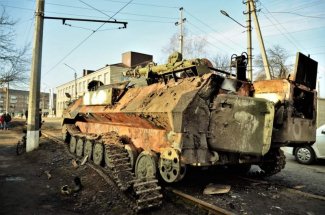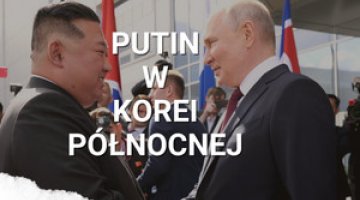Russia’s war against Ukraine: day 4

During the fourth day of the fighting, the Ukrainian side began to expand its embargo on information about the current situation (Russia has given no information about the course of the fighting from the very start). In his morning announcement, the General Staff of the Armed Forces of Ukraine enigmatically reported that Russian forces were continuing their air offensive, as part of which military and civil airports, Ukrainian command and air defence posts, important critical infrastructure, as well as inhabited areas and defending Ukrainian subunits are being destroyed. According to Kyiv, the enemy has slowed the pace of its offensive, but is still trying to achieve its aims in various directions. The Ukrainian side claims that all the Russian attempts to achieve their military goals have failed, and that Russian units are demoralised and suffering heavy losses.
Russian forces are tightening their blockade of Kyiv from the north and west sides, and reducing the distance between themselves and the Ukrainian capital on the eastern side. Russian sappers have prepared another crossing near the city. Fighting is continuing for the town of Irpen, which is close to Kyiv. Sabotage and reconnaissance groups (numbering 3–15 soldiers each) are allegedly operating within the capital. Ukrainians only control access to Kyiv from the south and the towns immediately east of the city (including Boryspil airport, which has been destroyed by attacks). The fuel depots at Vasylkiv, which the Russians bombed on the night of 26/27 February, is still ablaze and cannot yet be extinguished.
In the south, the focus of operations has shifted from Kherson oblast to Zaporizhzhia oblast. On 27 February, the Russians occupied Berdyansk on the Sea of Azov (they had bypassed the town the previous day, directing their columns towards Mariupol). As they continued to move along the eastern bank of the Dnieper, they reached Vasylivka, 160 km upstream of Nowa Kakhovka. There are contradictory reports on whether they have taken control of the Zaporizhzhia nuclear power plant (the largest in Ukraine) at Enerhodar, although they blocked access to it on 27 February.
The battle for Kharkiv is underway, with some clashes having already taken place within the city limits. The struggle for the Donbas has also resumed, with varying successes for each side: in the evening of 27 February, Ukrainian forces regained control of Volnovakh. There are no reports about how the fighting is progressing in other besieged or blocked oblast cities (Chernihiv, Sumy, Mariupol, Odessa); according to Ukrainian information, Odesa and the Odesa oblast are ‘riddled with’ saboteurs. There is also no information about the activities of a large landing group of combined forces from the Black Sea, Baltic and Northern Fleets (11 large landing ships in total), which reportedly left Sevastopol on in the evening of 27 February and were headed towards Odessa (earlier landings in the area were carried out by smaller special forces units). The airports in Mykolayiv and Zhytomyr have come under missile attack, as have Cherkassy city and its oblast.
According to the US Department of Defence, Russia has so far used two-thirds of its previously accumulated military potential in combat, and there are around 100,000 Russian soldiers on Ukrainian territory (the Armed Forces of Ukraine number about 250,000 soldiers, stretched along the entire border; a further 100,000 soldiers have been mobilised in recent days). 50,000 more Russian troops remain in direct reserve along the borders of Ukraine. The US has also reported incidents where the advancing Russian troops have encountered problems with their logistical security, including fuel supplies. By 27 February, 320 missiles, mostly short-range ballistic missiles, had fallen on Ukraine.
Ukraine’s Territorial Defence Forces have called on the civilian population to offer organised resistance, and issued instructions for engagement. As columns of Russian troops coming from the north appeared, calls were made to organise observation points identifying their movements; to block their passage by any means; to destroy bridges; to prepare and use Molotov cocktails; to use hunting rifles with optical sights, enabling accurate shooting at the tyres of armoured vehicles; to communicate information about prisoners; and to display banners reading ‘Only death awaits you here’, and amplify anti-Russian messages on social networks.
Ukraine’s Ministry of Defence released another statement about the losses of Russian troops since the beginning of the invasion. Since 24 February, the Russian Federation’s armed forces have reportedly lost 5300 soldiers, 191 tanks, 816 armoured vehicles, 29 aircraft and 29 helicopters. The Ukrainian side has emphasised that these reports are indicative and require clarification. The number of Ukrainian civilian casualties is also rising: 352 civilians, including 14 children, have died since the beginning of the aggression, and 1684 civilians, including 116 children, have been injured.
The Ukrainian government has agreed to start peace talks with Russia at a location near the Pripyat River on the Belarusian-Ukrainian border, without any preconditions. The meeting was agreed during a telephone conversation between President Zelensky and Alyaksandr Lukashenka (at the latter’s initiative). The conversation was preceded by Lukashenka’s harsh and irritated reaction to Zelensky’s speech on Sunday, in which he called on the Belarusian public to oppose the regime in Minsk for participating in the Russian aggression.
Zelensky said that the Russian troops’ actions bore the hallmarks of genocide. In his opinion, the purpose of the aggression is to terrorise and punish Ukrainian society for striving for sovereignty and independence. The president announced that he had discussed the matter with UN Secretary General Antonio Guterres. Ukraine has also brought a lawsuit against Russia at the International Court of the United Nations. The Ukrainian foreign minister Dmytro Kuleba has accused some Western politicians of wanting to continue economic cooperation with Russia, despite the war with Ukraine; he described this as an act of betrayal, trafficking in the blood of Ukrainian citizens.
The number of people crossing the border with Poland is still rising. According to data from the Polish Border Guard, 281,000 have entered from Ukraine since the beginning of combat operations (including almost 100,000 yesterday), and the queue to the border stretches between 20 and 30 km. Access to the western oblasts of Ukraine and the border zone itself is becoming increasingly difficult. There are checkpoints on the entry roads to the Lviv and Zakarpattia oblasts (40 so-called blockposts in the Lviv oblast) which, together with the increased amount of traffic, is causing enormous traffic jams.
Commentary
- In the military dimension, the last 24 hours have not brought any major changes. The Russian forces have focused on laying the groundwork for further battles for Kyiv by preparing the second-echelon forces (some of them entered Ukraine, mainly from Belarus, on 27 February). The offensives along the Dnieper River, as well as towards Kremenchuk from Kharkiv, have continued. This allows us to assume that the aim is not only to split Ukraine into eastern and western parts, but also to control the main elements of the state’s energy system. Similarly, activities aimed at taking control of the entire coast with its main ports (the Azov shore, with the exception of Mariupol, are entirely under the aggressor’s control), are part of a plan to cut off Ukraine’s goods from their main export route.
- The Ukrainian Armed Forces’ relative passivity, considering their significant numerical advantage over the enemy, should be explained in terms of the justified fear that if they undertake more active measures, Russia will decide to use air attacks on a large scale. Ukrainian units deployed for manoeuvring operations will be much more susceptible to Russian attacks than when they are undertaking defensive operations in often well-fortified positions. It is possible that the Russians are deliberately showing restraint in order to encourage the Ukrainian command to take just such actions (for example, by counterattacking north-eastwards and expelling the enemy from Kyiv), which would increase their chances of destroying the Ukrainian army’s land potential while limiting their own losses. However, the Ukrainian commanders seem fully aware of the dangers of abandoning strictly defensive activities.
- The fact that the Russian army has still not decided to use aviation on a mas scale, and that it is conducting its land offensive with smaller forces than those at Ukraine’s disposal (in terms of the art of war, this is distinctly unusual) probably results from political and economic calculations. We should assume that – especially in a situation where the use of aviation and radio-electronic warfare has so far been limited – Moscow is sending a signal to NATO that these methods are being saved for a fight with a more appropriate enemy, and it will not risk depleting them unnecessarily in clashes with the Ukrainian army. On the other hand (especially in comparison with the report on 27 February that Russian nuclear deterrent forces had been put on ‘special’ combat duty), this suggests a readiness for armed conflict on the Alliance’s eastern flank. Likewise, reports that Russia has used short-range ballistic missiles in some attacks suggest that the Russian army may be using the old Tochka-U missile system, keeping its more modern Iskanders in reserve.
- The territorial defence and special services of Ukraine have begun implementing the plan of ‘total defence’, encouraging the population to resist the aggressor. If the undertakings they have announced are successful, the Ukrainian potential for resistance will increase significantly. However, its effectiveness will depend not only on resolving organisational and logistical issues or transferring weapons and equipment; another, equally important factor will be maintaining morale among a society ready to resist aggression. Much indicates that the organisation of social resistance will bring tangible results, making it difficult for the Russian troops to operate safely in the territories they have temporarily occupied. Despite the advantages which the Russian forces hold, the activity of volunteer groups may also disrupt their logistics.
- The intensifying information offensive being waged by both combatants is making it harder and harder to assess the true situation in the combat zones. From the very beginning, the entourage of President Zelensky assumed that their message would focus solely on the successes of the Ukrainian army, regardless of the facts, as well as the failure of the Russian offensive and the aggressor’s problems. However, the events of the last 24 hours indicate that the Ukrainians are trying to standardise their message; they are not presenting so much information about the situation, and are instead focusing on maintaining the morale of the public and their men at arms.
- Moscow’s withdrawal from its previous preconditions for peace talks (that the Ukrainian army should lay down its arms, and the country should consent to neutral status) is most likely a smokescreen, and not a sign of any readiness to seek a compromise. Putin has not yet achieved his goals in Ukraine, and any agreement (even a formal concession by Ukraine) would be perceived at this stage of the conflict as proof of Russia’s weakness, which could strengthen Ukraine and confirm the correctness of the West’s assertive policy towards Moscow. Zelensky has explained his consent to holding talks in terms of the threat that Belarusian troops will join the invasion of Ukraine, as well as the need to seize upon every opportunity for an agreement, even the most minimal.
- The public popularity of Zelensky, who is perceived as the undisputed leader of the nation, has risen to a record high (94% of respondents support his actions). The public’s opinion of the effectiveness of the Ukrainian Armed Forces also remains high. 70% expressed the conviction that they would win over the Russian occupiers; this degree of confidence was higher in the western regions of Ukraine (78%) than in the southern (66%) or eastern regions (64%). Currently, despite the increasing difficulties which the civilian population are facing in their daily lives, there are no signs of a decline in morale, and the positive mood is being effectively bolstered by politicians and the media. At the same time, problems with food supply are growing: there are clearly fewer articles in many stores, and prices for basic products (especially bread) have risen significantly. In this situation, local authorities and the media are calling for attitudes of solidarity, especially towards the elderly and the isolated. On the other hand, incidents of shoplifting and looting are beginning, which have in turn provoked radical reactions from some local authorities: in Zhytomir and Okhtyrka, the local governments have announced that the police and law enforcement authorities will shoot looters on the spot to deter any further such acts.
Map. The Russian attack on Ukraine (as of 28 February 11 am CET)





